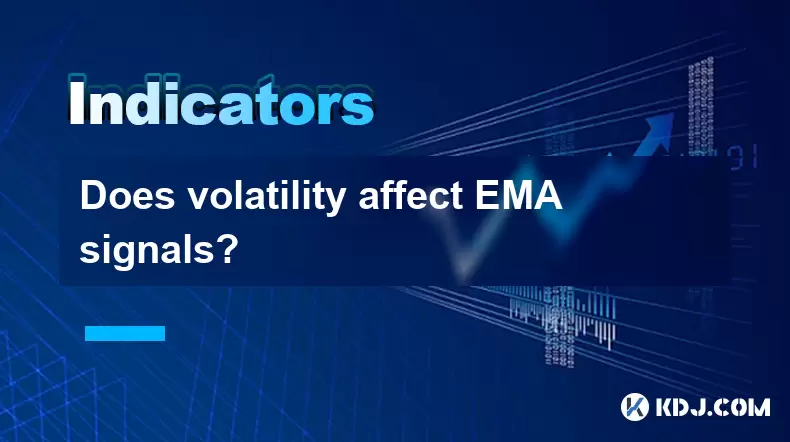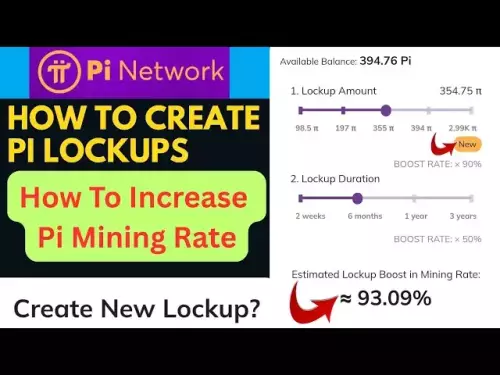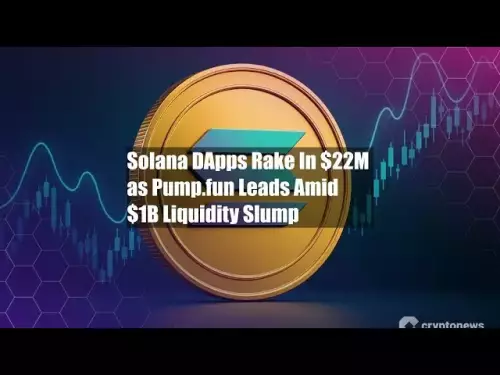-
 bitcoin
bitcoin $114779.865156 USD
2.30% -
 ethereum
ethereum $4226.519789 USD
2.39% -
 tether
tether $1.000545 USD
0.04% -
 xrp
xrp $2.890223 USD
0.92% -
 bnb
bnb $1030.029301 USD
2.95% -
 solana
solana $212.824944 USD
1.69% -
 usd-coin
usd-coin $0.999757 USD
0.01% -
 dogecoin
dogecoin $0.234961 USD
-0.27% -
 tron
tron $0.337174 USD
0.42% -
 cardano
cardano $0.804783 USD
0.09% -
 hyperliquid
hyperliquid $45.748770 USD
-2.85% -
 chainlink
chainlink $21.699170 USD
0.82% -
 ethena-usde
ethena-usde $1.001452 USD
0.08% -
 avalanche
avalanche $30.237800 USD
1.14% -
 stellar
stellar $0.372604 USD
1.52%
Does volatility affect EMA signals?
Volatility impacts EMA signals in crypto markets, causing whipsaws; traders can adjust EMA periods and use additional indicators to enhance signal reliability.
May 22, 2025 at 09:21 pm

Volatility is a critical factor that traders and investors in the cryptocurrency market must consider, especially when using technical indicators like the Exponential Moving Average (EMA). The question of whether volatility affects EMA signals is pivotal, as it can significantly influence trading decisions. In this article, we will explore the relationship between volatility and EMA signals, delving into how changes in market volatility can impact the reliability and interpretation of these signals.
Understanding EMA and Its Role in Trading
The Exponential Moving Average (EMA) is a type of moving average that places a greater weight and significance on the most recent data points. This makes it more responsive to new information compared to the Simple Moving Average (SMA). Traders often use EMAs to identify trends and potential entry or exit points in the market. For instance, a common strategy involves looking at the crossover of short-term and long-term EMAs to signal potential buy or sell opportunities.
The Nature of Volatility in Cryptocurrency Markets
Volatility refers to the degree of variation of trading prices over time. In the cryptocurrency market, volatility can be particularly high due to factors such as regulatory news, technological developments, and market sentiment. This high volatility can lead to rapid price movements, which in turn can affect the signals provided by technical indicators like the EMA.
How Volatility Impacts EMA Signals
When market volatility increases, the price movements become more pronounced, which can lead to whipsaws in the EMA signals. A whipsaw occurs when the price crosses the EMA multiple times in a short period, generating false signals. For instance, during a highly volatile period, the price might cross above the 50-day EMA, signaling a potential buy, only to quickly drop back below it, triggering a sell signal shortly after. This can lead to confusion and potential losses if traders react to these signals without considering the context of increased volatility.
Adjusting EMA Settings in Response to Volatility
To mitigate the impact of volatility on EMA signals, traders can adjust the period length of the EMA. A shorter period EMA, such as a 10-day EMA, will be more sensitive to price changes and can be useful in highly volatile markets. Conversely, a longer period EMA, like a 200-day EMA, will be less sensitive and can help filter out short-term noise. Traders must find a balance that suits their trading style and the current market conditions.
Practical Example of EMA Signal Adjustment in Volatile Markets
Consider a scenario where the cryptocurrency market experiences a sudden surge in volatility due to a major news event. Here’s how a trader might adjust their EMA strategy:
- Identify the current volatility level: Use tools like the Average True Range (ATR) to gauge the current level of volatility.
- Adjust the EMA period: If the volatility is high, switch to a shorter period EMA, such as a 10-day or 20-day EMA, to capture more immediate trends.
- Monitor the signals: Keep an eye on how the price interacts with the adjusted EMA. Look for consistent patterns rather than reacting to every minor crossover.
- Combine with other indicators: Use additional indicators, such as the Relative Strength Index (RSI) or Bollinger Bands, to confirm the EMA signals and reduce the risk of false signals.
The Role of Backtesting in Volatile Markets
Backtesting is an essential tool for traders looking to understand how their EMA strategies perform under different levels of volatility. By applying historical data to their chosen EMA settings, traders can see how well their strategy would have worked in past volatile periods. This can help in fine-tuning the strategy to better handle future volatility spikes.
Case Studies: EMA Signals in Different Volatility Scenarios
To illustrate the impact of volatility on EMA signals, let’s look at two case studies from the cryptocurrency market:
- Case Study 1: Low Volatility Period: During a period of low volatility, such as a stable bull market, the 50-day EMA might provide reliable signals with fewer false positives. The price might cross the EMA once and continue in the direction of the trend, making it easier for traders to follow.
- Case Study 2: High Volatility Period: In contrast, during a high volatility period, such as after a major regulatory announcement, the same 50-day EMA might generate multiple false signals. The price could swing back and forth across the EMA, leading to confusion and potential losses if traders do not account for the increased volatility.
Combining EMA with Volatility Indicators
To enhance the reliability of EMA signals in volatile markets, traders can combine the EMA with volatility indicators. For example, the Bollinger Bands can be used to gauge the current volatility level. When the bands widen, it indicates increased volatility, which might warrant a more cautious approach to EMA signals. Conversely, when the bands narrow, it suggests lower volatility, potentially making EMA signals more reliable.
The Psychological Impact of Volatility on EMA Signal Interpretation
Psychological factors play a significant role in how traders interpret EMA signals during volatile periods. High volatility can lead to emotional trading, where traders might overreact to EMA crossovers. It’s crucial for traders to maintain discipline and not let fear or greed dictate their decisions. Understanding the psychological impact of volatility can help traders stay focused on their strategy and avoid making impulsive trades based on EMA signals.
Frequently Asked Questions
Q1: Can using multiple EMAs help in volatile markets?A1: Yes, using multiple EMAs can provide a more comprehensive view of the market trends. For instance, combining a short-term EMA (like a 10-day EMA) with a long-term EMA (like a 50-day EMA) can help traders identify both short-term fluctuations and longer-term trends. This dual approach can be particularly useful in volatile markets, as it allows traders to see the bigger picture while still being responsive to immediate price changes.
Q2: How often should I adjust my EMA settings in response to volatility?A2: The frequency of adjusting EMA settings depends on the trader's strategy and the specific market conditions. Some traders might adjust their settings daily or even intraday if they are actively trading in highly volatile markets. Others might make adjustments less frequently, such as weekly or monthly, if they are swing trading or investing for the longer term. It's essential to monitor market conditions and adjust settings as needed to maintain the effectiveness of the EMA signals.
Q3: Are there other technical indicators that work better than EMA in volatile markets?A3: While the EMA is a popular choice, other indicators like the Moving Average Convergence Divergence (MACD) or Bollinger Bands can also be effective in volatile markets. The MACD can help identify momentum shifts, which can be particularly useful during periods of high volatility. Bollinger Bands, on the other hand, can provide insights into volatility levels and potential price breakouts. Combining these indicators with the EMA can create a more robust trading strategy.
Q4: How can I use volatility indicators to confirm EMA signals?A4: Volatility indicators like the Average True Range (ATR) or Bollinger Bands can be used to confirm EMA signals. For instance, if the ATR shows increased volatility, traders might wait for additional confirmation from other indicators before acting on an EMA crossover. Similarly, if the price touches the upper or lower Bollinger Band, it might indicate a potential reversal, which can help traders decide whether to follow an EMA signal. Using these indicators in conjunction with the EMA can enhance the reliability of trading signals in volatile markets.
Disclaimer:info@kdj.com
The information provided is not trading advice. kdj.com does not assume any responsibility for any investments made based on the information provided in this article. Cryptocurrencies are highly volatile and it is highly recommended that you invest with caution after thorough research!
If you believe that the content used on this website infringes your copyright, please contact us immediately (info@kdj.com) and we will delete it promptly.
- The Spanish Silver Dollar: A Global Currency Through History
- 2025-09-30 14:25:15
- SEC, Crypto, and Regulation: Navigating the Shifting Sands of Digital Finance
- 2025-09-30 14:25:15
- Government Grift, Congress, and ETF Tracking: Is This the Future of Investing?
- 2025-09-30 14:30:01
- CoinShares' Market Metrics: Bitcoin's Calm Amidst Fed Rate Tweaks
- 2025-09-30 14:30:01
- Nonprofit RFI Launches: Bridging Traditional and Decentralized Financial Systems
- 2025-09-30 14:30:01
- Emilio Lozoya's audience: REAL-TEME UPDATES VIA WHASTASP?
- 2025-09-30 14:30:15
Related knowledge

What is a tower bottom candlestick pattern? Does it have a high success rate?
Sep 22,2025 at 07:18am
Tower Bottom Candlestick Pattern Explained1. The tower bottom candlestick pattern is a reversal formation that typically appears at the end of a downt...

What is a black hole pattern in the MACD indicator? Is it a cause for concern?
Sep 21,2025 at 06:54pm
Bitcoin's Role in Decentralized Finance1. Bitcoin remains the cornerstone of decentralized finance, serving as a benchmark for value and security acro...

How can I use the psychological line (PSY) to determine market sentiment?
Sep 17,2025 at 02:19pm
Understanding the Psychological Line (PSY) in Cryptocurrency TradingThe Psychological Line, commonly referred to as PSY, is a momentum oscillator used...

How can I determine if a double top pattern has officially formed?
Sep 21,2025 at 03:18am
Understanding the Structure of a Double Top Pattern1. A double top pattern consists of two distinct peaks that reach approximately the same price leve...

What is the Golden Valley pattern on the moving average? Is it better than the Silver Valley pattern?
Sep 21,2025 at 02:54pm
Understanding the Golden Valley Pattern in Moving Averages1. The Golden Valley pattern is a technical formation observed in cryptocurrency price chart...

What does a death cross of the RSI in the strong zone (above 50) mean?
Sep 17,2025 at 10:54pm
Understanding the Death Cross in RSI Context1. The term 'death cross' is traditionally associated with moving averages, where a short-term average cro...

What is a tower bottom candlestick pattern? Does it have a high success rate?
Sep 22,2025 at 07:18am
Tower Bottom Candlestick Pattern Explained1. The tower bottom candlestick pattern is a reversal formation that typically appears at the end of a downt...

What is a black hole pattern in the MACD indicator? Is it a cause for concern?
Sep 21,2025 at 06:54pm
Bitcoin's Role in Decentralized Finance1. Bitcoin remains the cornerstone of decentralized finance, serving as a benchmark for value and security acro...

How can I use the psychological line (PSY) to determine market sentiment?
Sep 17,2025 at 02:19pm
Understanding the Psychological Line (PSY) in Cryptocurrency TradingThe Psychological Line, commonly referred to as PSY, is a momentum oscillator used...

How can I determine if a double top pattern has officially formed?
Sep 21,2025 at 03:18am
Understanding the Structure of a Double Top Pattern1. A double top pattern consists of two distinct peaks that reach approximately the same price leve...

What is the Golden Valley pattern on the moving average? Is it better than the Silver Valley pattern?
Sep 21,2025 at 02:54pm
Understanding the Golden Valley Pattern in Moving Averages1. The Golden Valley pattern is a technical formation observed in cryptocurrency price chart...

What does a death cross of the RSI in the strong zone (above 50) mean?
Sep 17,2025 at 10:54pm
Understanding the Death Cross in RSI Context1. The term 'death cross' is traditionally associated with moving averages, where a short-term average cro...
See all articles










































































